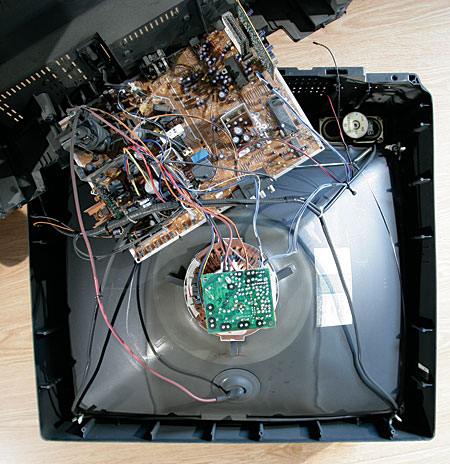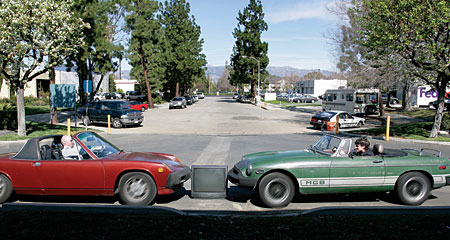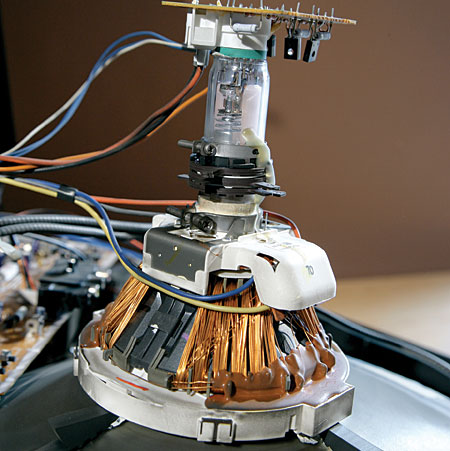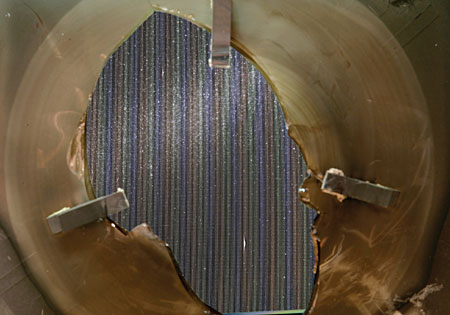The Death and Life of CRT
Don't get me wrong—I love CRT displays. They still offer the best picture quality across the board, and I can't imagine having anything else for my computer monitor. That said, the technology isn't long for this world. Fewer and fewer companies are coming out with new models as consumers spend their money on big screens and flat panels. So, when contributor John Higgins mentioned that his TV had died, I knew what had to be done. I needed to give it a fiery send-off. I needed to destroy it.

Relics of the 20th century face off.
My first thought was to tie it to the back of a car and surf it down the street. This, as you can imagine, was a stupid idea. After all, I can't surf, and it would take far too long. And how many times do you think we would have made it around the block before the cops pulled us over?
My next thought was to tie the TV between my car and Higgins' and tear the set asunder. Nope, I stopped this one, too. If you look at our cars, you'll see that there was a good chance the TV would tear them apart.

You didn't attach that to the bumper, did you?
OK, last chance. We'll crush it with the cars! We lined up the cars, and. . .hmmm, too much glass. Well then, I'll be boring and just take it apart. After all, I've never seen what was inside a picture tube (a vacuum!).
Ancient Technology
This TV was manufactured at the end of the last century. While it is standard def, it is still pretty indicative of what CRT TVs look like now, as well as before. Twenty years ago, there would have just been more stuff inside. The circuit boards were bigger and more numerous, and there were more wires and plastic bits. This is because companies figured out ways to use fewer, more integrated parts (less money), while incorporating new technology (more features).

Geoffrey don't surf.
Figure 1 shows a top-down view of the main circuit board and the back of the tube. On the upper middle of the circuit board is the input stage, in this case just S-video and composite video. At the upper right is the tuner (the small, vertical metal box). The tall cylinder on the upper left is the do-not-touch high-voltage power supply. Figure 2 is more interesting. This is where much of the magic happens. This is the back of the tube, with the electron guns (encased in a glass tube) and the deflection coils or yoke (copper wires).

Figure 1: CRT guttiwuts
For simplicity, let's say this is a black-and-white TV. We'll worry about the color electronics later. The electron gun is located within the vacuum tube, with a cathode (a heated piece of wire) inside. This cathode emits electrons. These electrons are pulled towards an anode, which is in line between the cathode and the screen. So, the electrons get pulled toward the anode and, therefore, along toward the screen. The deflection coils use magnetic fields to steer the electrons in a pattern along the screen, starting at the top left (as you would see it seated in front) to the bottom right, line by line. It paints the 240 odd-numbered lines (1, 3, 5, 7. . .) in 1/30 of a second. Then, in the next 1/30 of a second, it goes back and paints the 240 even-numbered lines. There's your 480i (interlaced) of regular TV. When the electrons hit the screen, they (hopefully) hit a phosphor. This phosphor gets all excited and emits light.

My Money is on the TV
Color TVs usually have three electron guns, one each for the red, green, and blue colors that comprise the picture. The electrons themselves have no color, which is where the different phosphors come in. With precise aiming and the help of a shadow mask between the gun and the phosphors, each stream of electrons hits only a certain colored phosphor—red, green, or blue. Sony's Trinitron CRTs have a slightly different way of doing a shadow mask, but it functions roughly the same way.

Figure 2: The back of the tube
Where CRT's benchmark black level comes in is that, if a pixel isn't supposed to be lit, the electron beam skips over it. With no electron stream hitting the phosphor for that pixel, it remains dark. So black here is actually the absence of light. So far, all other display technologies are trying fancy tricks to mimic what CRTs do by their very nature: create a decent black level.
Don't Try This at Home
I'm sure many of you have done this before, but don't try it again. A CRT is called a vacuum tube for a reason. There's just a thin layer of glass keeping the outside world from the vacuum. This means CRTs implode when trauma, like say a crowbar, is applied.

Figure 3: Back of the shadow mask
As you can imagine, there was significant cleanup required. But, thanks to some brute force, you can see the back of the shadow mask in Figure 3. In Figure 4, you can see the phosphors, lit from the viewing side. Light angles being what they are, you can see bands of colors instead of the individual columns of red, green, and blue phosphors.
With My Last Breath. . .
Color CRTs have served us well for more than half a century. By the end of the 20th century, development had pushed them to the pinnacle of picture quality. Their color reproduction (due to decades of phosphor research), response time (due to their nature and the phosphors), black level, and detail were all of a quality that other display technologies strived for but could not match.

Figure 4: Phosphors lit from other side
But money and competition are excellent movers of technology. In the past few years, we've seen products with similar color accuracy, better detail, and with huge improvements in response time and black level. Worse, they have taken CRTs on where CRTs can't compete: size. A 42-inch CRT would weigh hundreds of pounds and never be flat enough to hang on a wall.
We're already seeing the decline of CRT purchase and manufacturing. Within a few years, CRTs will be all but gone, replaced by cheaper and cheaper plasmas and LCDs. With the rate of advancement being what it is, these new technologies could replace CRTs not just in sales but maybe in picture quality, as well. Or perhaps that succession lies in one of the technologies that is on the horizon, like OLED or SED. The latter works by firing electrons at phosphors. Sound familiar?












































